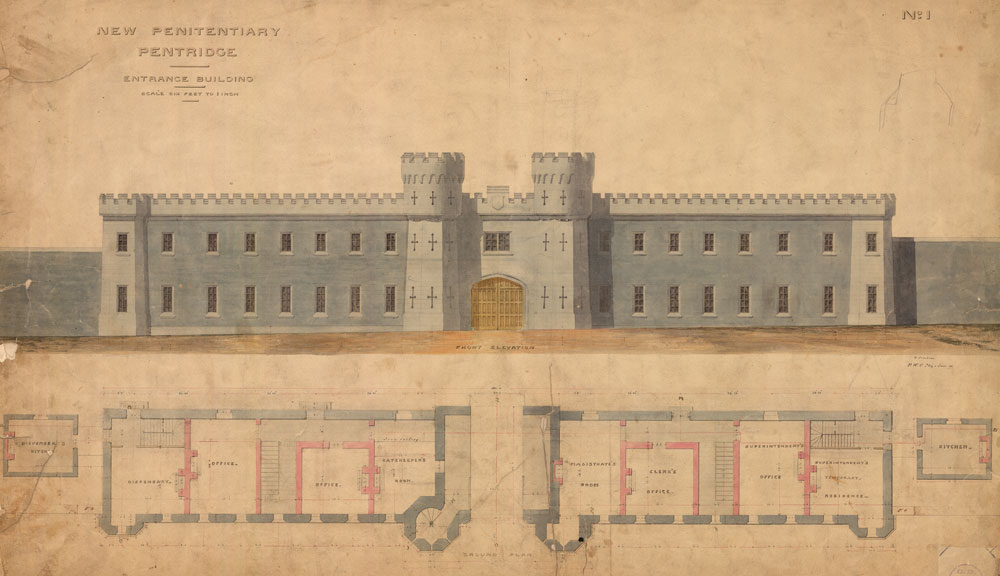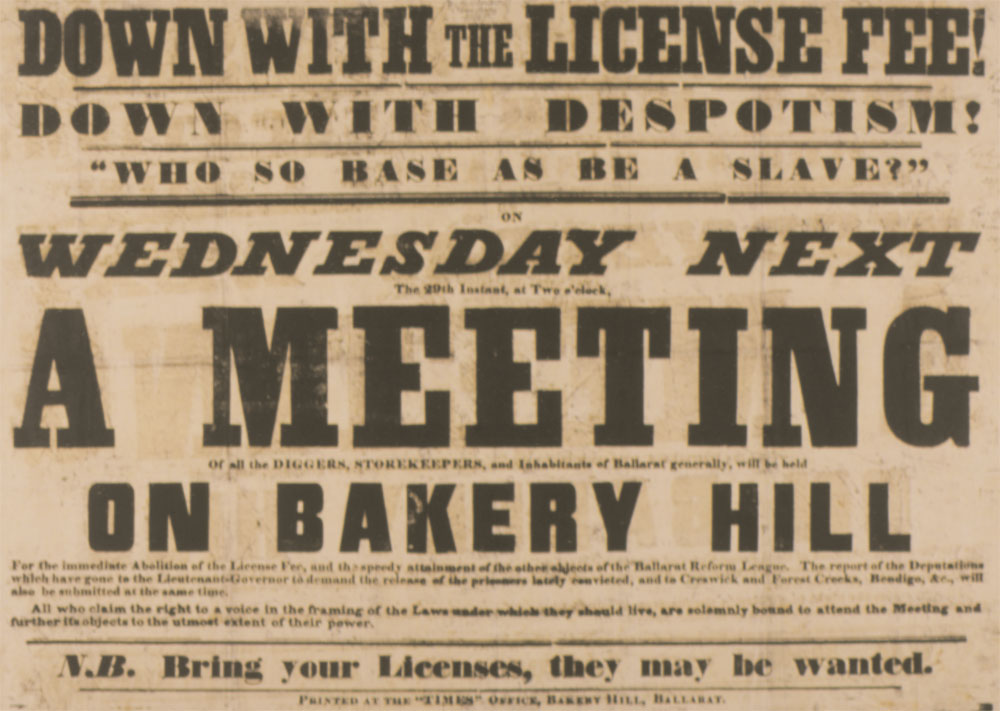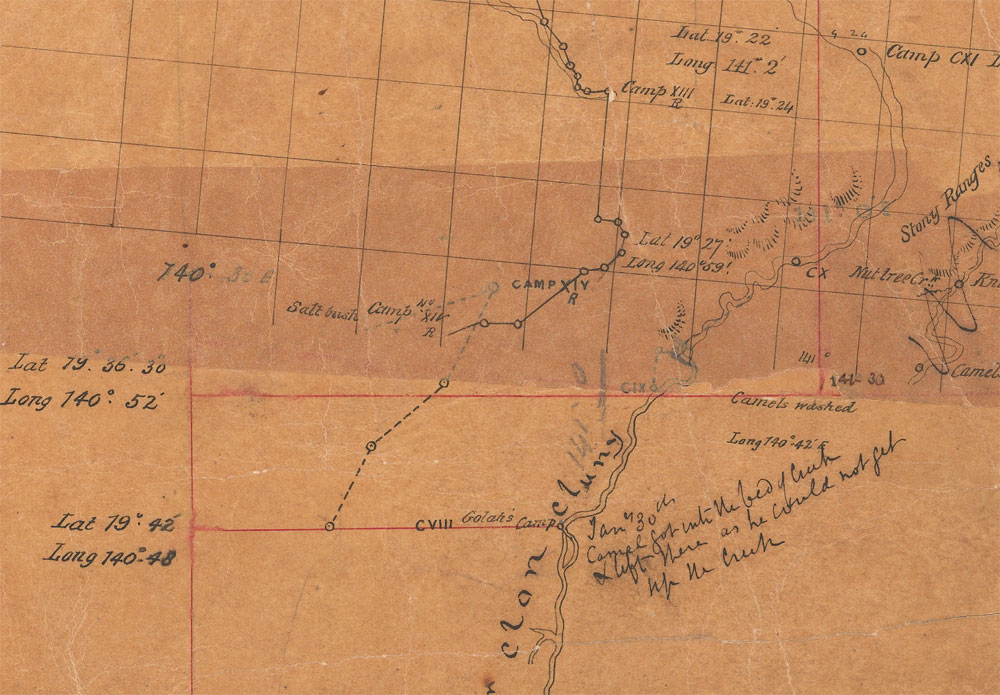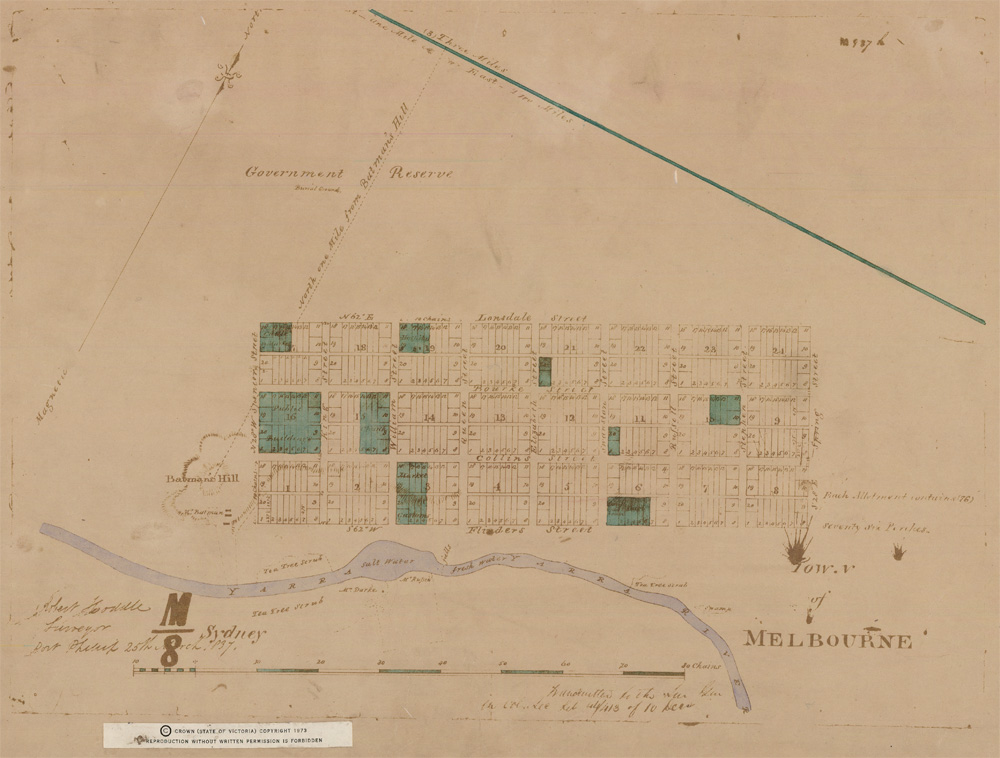Last updated:
‘Exhibiting PROV at the Old Treasury Building’, Provenance: The Journal of Public Record Office Victoria, issue no. 10, 2011. ISSN 1832-2522. Copyright © Kimberley Meagher and Jill Barnard.
In the first few months of 2010, a team of PROV staff members worked to prepare a permanent exhibition of PROV records at the Old Treasury Building in Spring Street, Melbourne. Victorian Archival Treasures opened on 6 June 2010 and has since been complemented by temporary displays using additional records from PROV’s collections. Kimberley Meagher and Jill Barnard, members of the exhibition team, reflect on the exhibition process and explore some of the personal highlights and challenges involved in using PROV records in an exhibition.
Promoting and showcasing government records to the public might be considered, by some, to be a bit boring and dry. The archival material is often two-dimensional and consists mostly of paper documents, posing challenges for those who seek to exhibit it in a meaningful way. It could be said that other cultural institutions have an easier job of it, as they have a more diverse range of cultural objects to choose from. But historians know it is the stories that lie within these documents that make them such fascinating and important relics of our past. With imagination and interpretive context, not to mention eye-catching graphics, these documents and the stories they tell can be brought to life.
The Victorian Archival Treasures exhibition at the iconic Old Treasury Building is a wonderful opportunity for PROV to reach out to new audiences, to have a presence in the Melbourne CBD and to make these hidden archival treasures more widely known. The exhibition opened on 6 June 2010, and the initial response by the public suggests it has been well received. There have been over ten thousand visitors to date,[1] and Old Treasury was one of the top ten buildings visited as part of the 2010 Melbourne Open House weekend event which occurred not long after the opening of the exhibition.[2]
Thirteen thematic areas form the backbone of the exhibition. Some provide a context for showcasing PROV’s rich store of photographs, illustrations and building plans. Others highlight the splendour of the Old Treasury Building, built in the late 1850s. The thematic areas focus on significant strands of Victoria’s history – Indigenous Victorians, Early Melbourne, Victorian Democracy and the part played by 1850s gold miners in bringing this about. Themes such as Ned Kelly, Crimes and Criminals, and Family History Research demonstrate the range of records held by PROV.
As one of the central aims of the exhibition is to showcase PROV holdings, Victorian Archival Treasures differs from many museum exhibitions in that very few objects or records are borrowed from other cultural institutions. Aside from some illustrative material incorporated into exhibition panels, and a significant field book kindly loaned by the Victorian Surveyor-General, all items on display and most of the illustrative material are derived from PROV’s collections. PROV records were also the source of a significant amount of the information that was used in the interpretive panels, so that research for the exhibition became a sort of archaeological dig.
The layout of Old Treasury to some extent provided the parameters for the exhibition’s content or, more importantly, its themes. The corridors have been utilised for explaining PROV, the Old Treasury Building and its architect, JJ Clark, as well as for displaying large pictorial banners which describe and capture the themes of Victoria’s Buildings, Victorians on Holidays and Victorians at Work. The rooms to the southern end of the building on the ground floor are used to explore five themes: Indigenous Victorians, Early Melbourne, Ned Kelly, Criminals, and Victorian Democracy.
It is fascinating to see just what is captured in the archives. You’ll find snippets of stories about the Pepper family, William Barak, the Native Police Corps and early government policy towards Aboriginal people in Port Phillip in the first room. Next up in the Early Melbourne room are Hoddle’s maps and plans, the story of Burke and Wills, and records about the Yarra River. Having covered the 1830s, the gold rush and the Burke and Wills expedition, step into Kelly time during the 1870s and 80s. Watch rare footage of a film from 1905 depicting Ned’s story and see the confiscated film poster found in the police files. Crime in the 1920s is intriguing: just two case studies, Colin Ross and Squizzy Taylor, offer a glimpse into Melbourne City and the nearby suburbs of Fitzroy and Carlton with twists and turns that you thought only happened in the movies. Victorian Democracy charts the democratic innovations of our forefathers (and mothers). Taking the time to understand the past, and how it shapes our present and future, provides context and respect. The exhibition at Old Treasury is an opportunity for all to delve into the archives, and it has revealed much about the Victorian character.

So what were some of the archival treasures? And what were the highlights and challenges?
You may have been on a tour through the PROV repository, and if you are reading this it is very likely you are interested in history. Chances are, you wish you could rummage through the PROV archives and spend hours opening boxes, looking at pictures, plans, books, discovering random gems hidden in all sorts of nooks and crannies – or rather, boxes, drawers, plan presses, cold storage.
Digging in the Repository: Kimberley Meagher’s Perspective
I started at PROV as an Access Services Officer, a staff member who retrieves your record and puts it away, as well as providing guidance about records in the reading room. This role is part of a very busy service area at PROV and there is simply no time for exploring the repository in search of random gems, even though I often dreamed of doing just that.
Sometimes you get your wish … and I got mine when I was seconded to the Victorian Archival Treasures project. The only problem was that we had an extremely tight deadline. We did not have the normal development time-frame for producing an exhibition of this scale, which usually requires up to two years of preparation, research, conservation, design, manufacture and installation. The task was to produce a full-scale exhibition showcasing PROV’s holdings essentially within three months. Looking back I am not completely sure how we managed to achieve this and still find time to identify some remarkable records as we explored the archive’s diverse collections.
One visual highlight, and certainly one of the impressive features of the exhibition, is the enormous banner of architectural plans situated in the corridor of Old Treasury. My task was to identify aesthetically pleasing plans of iconic buildings in Victoria, a project that was a pleasure for me as my personal and professional interest is in architectural history.
There were two approaches:
A. Research a list of pre-determined iconic Victorian buildings using traditional PROV methods;
B. Rummage (carefully!) through plan drawers, and visually select plans of buildings/structures that were reasonably iconic.
Approach A was time-consuming, as all researchers know and understand, and limited by what records were available for individual places. Seeking attractive plans and elevations of the Manchester Unity Building? Quite elusive, in the end. There were specification plans for various aspects of the site, including the shops on the ground level, but no final presentation drawings. Perhaps this was not so surprising, as the incomplete plans were found in a series containing building applications to the City of Melbourne.[3]
While I was looking in tubes for specific building plans I did find an interesting (and colourful) vernacular bus depot plan, which indicated to me I should change my approach. I had better luck with the Forum Theatre, but no luck with the City Baths, Princess Theatre, cathedrals, or the General Post Office – the list goes on. The series investigated were VPRS 11202 (Building Application Index 1916-1933), 11201 (Building Application Files 1916-1960), 11200 (Building Application Plans 1916-1946) and 16127 (Fitzroy Building Plans 1920-1990).
Approach B (manually looking through plan press drawers) enabled the discovery of a water-coloured elevation on canvas of Pentridge Prison; competition drawings for the Shrine of Remembrance; technical plans for Sidney Myer Music Bowl; and beautiful early drawings of school buildings (Queensberry Street and Upper Maffra schools were selected), the teahouse in Fitzroy Gardens, Government House gates, Harbour Master’s office building, Melbourne Observatory telescope room, a judges’ canopy at the Supreme Court, and Princes Bridge, just to name a few. The series accessed was VPRS 3686 (Pre-Metric Building Plans of the Public Works Department).[4]


It is quite clear to me which approach was the successful one. Being able to sift through plans manually was most effective, particularly considering my brief, which required colourful and eye-catching drawings. Black and white drawings were generally not considered, despite the quality of line work and draughtsmanship, the exception being the Split Point Lighthouse whose spiral staircase frames the architectural banner. Essentially the banner succeeds in demonstrating the potential of the archives.
Interpreting the Discoveries: Jill Barnard
While the stunning visual appeal of the architectural drawings made them easy to display and required very little interpretation, it was not always so easy with other aspects of the exhibition. An important aim of the project was to demonstrate that documents capture key moments in Victoria’s history and are valuable artefacts in their own right. The exhibition was also planned to encourage visitors to make greater use of PROV’s many resources.
Not all of the iconic documents relating to Victoria’s past are visually exciting. A substantial portion of the exhibition was devoted to the Eureka Stockade and its effect on the development of Victorian democracy. Happily, many of the records about this event are evocative. The poster calling for a meeting of miners on Bakery Hill, Ballarat on 29 November 1854 is an iconic document and visually attractive at the same time.[5] A map of the route taken by troops towards the Eureka Stockade that was used in the 1855 treason trial of some of the stockaders is similarly evocative.[6] But what of records that, to the historian, are highly significant, but betray very little of their significance to the exhibition visitor? The minutes of a meeting between Lieutenant-Governor Hotham and three Ballarat miners found in VPRS 1095/P0 is one such example.[7] This document records the meeting at which the representatives of the Ballarat Reform League presented the Lieutenant-Governor with the League’s Charter. It sets out the Ballarat miners’ many grievances and concerns, as explained by the League’s delegates George Black, John Humffray and Thomas Kennedy, and details Hotham’s responses. It is a pivotal document in the story of Eureka. Yet it is an unprepossessing document of at least fifty handwritten pages, with a simple covering page that betrays none of its significance. It is impossible to read it in any detail in an exhibition context. Bringing to life such a dramatic event from a not overtly engaging record was one challenge we faced as we mounted the exhibition and it was necessary to provide more detailed interpretation of the item displayed in order to explain its significance.

A positive aspect of the preparation of the exhibition was the opportunity it provided to search across a number of PROV series for records relating to a particular theme and to use material not only for background research and as potential exhibits but also to demonstrate the wealth of material that lies within the repository. This approach was particularly rewarding when it came to the Burke and Wills Exploring Expedition, which was included in the exhibition to commemorate the centenary of the ill-fated 1860-61 venture. Although the expedition had been mounted by the Royal Society of Victoria, a significant proportion of the funding came from the Victorian Government and correspondence is contained in PROV series 1189, the inward registered correspondence of the Chief Secretary’s department. Unit 757 of this series contains a wealth of material spanning the years 1858-65 and tells the story of the expedition from the initial request for funds and a statement of aims through to the purchase of camels in India, the employment of Robert O’Hara Burke as leader of the exploration party, the hiring of search parties and finally the erection of a monument to the lost explorers in Melbourne. The Historic Plan Collection (VPRS 8168) also yielded treasures relating to Burke and Wills. Here, a tracing of Wills’s map from Coopers Creek to the Gulf of Carpentaria was discovered, along with several other versions of the explorers’ route, demonstrating, as an additional point of interest, stages in the printing processes of the nineteenth century.[8] The tracing includes the campsites used by the explorers, notes about terrain and, sometimes, even alternative names for campsites. Finally, VPRS 14515 yielded a photograph of Charles Summers’s statue of the explorers.[9]


The Historic Plan Collection in which Wills’s maps are located is normally closed to researchers, with access to the original plans only available with the permission of Victoria’s Surveyor-General. Researchers must make do with microfiche copies of these plans located in VPRS 15889. It was a joy, therefore, to find the original tracing of Wills’s map, pasted in sections on an immense cardboard sheet that, in itself, represented the enormous scale of the journey the explorers had undertaken. Unfortunately, however, conservation issues prevented us from using this in the exhibition. The solution was digitisation: a digitised version of the map – though not quite as big as the original – was carefully prepared for display. It is true that the digitised version lacks the romance of the original. But one advantage of digitisation is that it captures many features of the original map that cannot be seen with the naked eye.
Digitisation made other significant records accessible for the purpose of the Victorian Archival Treasures exhibition. One thematic area was devoted to the earliest days of Melbourne – focusing on the first settlement by independent settlers John Pascoe Fawkner and John Batman and on early government interventions in the settlement in the form of plans of Melbourne by surveyors Robert Russell and Robert Hoddle. A search of VPRS 2/P0 (Confidential Despatches to Governor Bourke) revealed early letters from Police Magistrate William Lonsdale to the governor. Like the Historic Plan Collection, VPRS 2/P0 is closed to researchers owing to the fragile nature of the records and the alternative is a barely readable photocopied version of the despatches (VPRS2/P1). But access to the original records showed that, in one of his first despatches to the governor, Lonsdale was able to report that the early settlers in the Port Phillip District were thankful that the governor had established an outpost of government in the fledgling settlement ‘as many of the lower order of people, who had come over on adventure, were taking advantage of the absence of power to behave in a lawless and intimidating manner’, adding another textural layer to the story of Melbourne’s infancy.[10] Digitisation of this record enabled an excerpt to be displayed within an exhibition panel in a readable form.

Digitisation clearly helps to overcome conservation issues and improves accessibility to records. However, within the context of an exhibition named Victorian Archival Treasures it also poses some conundrums for, as noted above, many of the records showcased in the exhibition are iconic documents from PROV’s collections. Viewing a remarkably good replica is not quite the same experience as having a tangible link to key moments in the past that viewing the original record can provide. Assistant Protector of Aborigines, William Thomas’s 1841 map of Westernport – showing Indigenous routes and place names – and his census of Boon-wurrung and Woi-wurrung people in 1839 are two such iconic documents.[11] They vividly illustrate aspects of relations between the colonial government and Indigenous Victorians during the earliest years of contact and were selected for inclusion in the exhibition space devoted to Indigenous Victorians. Because of conservation concerns, however, these records could only be displayed for a limited time; the exhibition, therefore, had to be planned to allow for the rotation of the records on display, thus limiting public access to some treasures.
Despite the limited public access to iconic records on display, the exhibition does offer all Victorians and visitors increased access to the riches held in PROV’s collections. It provides a glimpse into the kinds of records PROV holds and an insight into how these records tell the story of Victoria. It has the potential to increase public use of PROV’s search rooms as well as PROV’s online catalogues and digitised records. For those PROV staff who worked to prepare the exhibition, there were opportunities to explore the collection and to make links between series. The constraints of a strictly limited time period in which to prepare the exhibition were frustrating. This was evident to us on the few occasions when we had the opportunity to search out obscure records, as we often reaped wonderful rewards. The exhibition team often had to rely on research that had been conducted for previous PROV exhibitions, adding value where we could. This was in contrast to the methods used by many researchers at PROV, who have the time to painstakingly search out records that might be of interest or use in their research and can build up a historical case from their discoveries over an extended period of time.
The Victorian Archival Treasures exhibition includes temporary exhibits, which means there are always new items to view, not to mention those documents and records on rotation that offer a new perspective on the themes. So despite the challenge of producing an exhibition in just three months, the versatility of the records and the breadth of stories contained within them offset the difficulties faced, and continue to inspire the potential discovery of knowledge, gems and treasures yet to be uncovered.
Endnotes
[1] Diane Gardiner, Manager, Old Treasury Building, pers. comm., 24 March 2011.
[2] ‘Melbourne Open House 2010 sets a new record’, media release of Melbourne Open House Inc., Sunday 25 July 2010 (accessed 5 September 2010).
[3] For details on accessing these records refer to the PROV online search guide City of Melbourne building plans and permits (1916-1960), available at: <https://prov.vic.gov.au/explore-collection/explore-topic/city-melbourne/city-melbourne-building-plans-and-permits-1916-1960>, accessed 26 March 2020.
[4] For further information on how to access these plans see PROV online search guide for the Public Works Department (Building Services Agency) available at: <https://prov.vic.gov.au/explore-collection/explore-topic/researching-land-and-property/public-works-department-plans>, accessed 26 March 2020.
[5] PROV, VPRS 5527/P0 Eureka Stockade – Historical Collection, Unit 4, Item 1.
[6] ibid., Unit 3.
[7] PROV, VA 466 Lieutenant-Governor, VPRS 1095/P0 Special Files, Unit 3, Bundle 1, no. 16.
[8] PROV, VA 538 Department of Crown Lands and Survey, VPRS 8168/P2 Historic Plan Collection, Unit 871, Items EXP22A, EXP22B; Units 857, 866, 896.
[9] PROV, VA 714 Education Department, VPRS 14515/ P1 File Prints of Photographs [Publications Branch], Unit 36, Item P342.
[10] PROV, VA 472 Police Magistrate Port Phillip District, VPRS 2/P0 Confidential Despatches to Governor Bourke, Unit 1, Item M5182.
[11] PROV, VA 538 Department of Crown Lands and Survey, VPRS 6760/P0 Aboriginal Estrays, Unit 1, Item 1; PROV, VA 473 Superintendent, Port Phillip District, VPRS 10/P0 Inward Registered Correspondence relating to Aboriginal Affairs, Unit 1, Item 1839/242.
Material in the Public Record Office Victoria archival collection contains words and descriptions that reflect attitudes and government policies at different times which may be insensitive and upsetting
Aboriginal and Torres Strait Islander Peoples should be aware the collection and website may contain images, voices and names of deceased persons.
PROV provides advice to researchers wishing to access, publish or re-use records about Aboriginal Peoples
